MHF TOP PICKS FOR MARCH
Every month, we at the Mueller Health Foundation like to showcase interesting news and updates in the field of tuberculosis. Below are our top 3 picks for March:
- New Smartphone App Could Help Diagnose TB and Monitor Treatment
The latest app advancement under investigation in clinical trials is a cough monitoring system called Hyfe AI. This smartphone-based app runs specialized software that calculates a person’s cough rate hourly. With this information, healthcare providers could have the data they need to diagnose TB and determine if TB treatment is effective. To investigate the usefulness of Hyfe AI, researchers recently conducted a study using the new app technology to monitor coughing in people presumed to have TB in Uganda, South Africa, the Philippines, Vietnam, and India. The scientists then compared the cough patterns between people with microbiologically confirmed TB, clinical TB, and other respiratory diseases (ORD). Although more research is needed, scientists suggest that cough-based TB screening may help reduce the overtreatment of people without TB and improve the detection of the condition. To learn more about the research, you can access the full paper at: https://www.ncbi.nlm.nih.gov/pmc/articles/PMC9983626/#i1815-7920-27-3-221-b1
- A New Community-Based Diagnostic Technique for Tuberculosis
A new, low-cost, scalable package for diagnosing tuberculosis (TB) onsite in resource-poor community settings is feasible and effective, according to a new trial. A portable, battery-operated, molecular diagnostic tool, Xpert, was able to detect almost all likely infectious cases of the disease in a community trial of almost 600 participants in South Africa. The XACT mobile clinic model is a relatively low-cost package comprising a vehicle operated by two healthcare workers that contains newer portable battery-operated DNA-based diagnostics, and equipment to obtain sputum samples even when patients cannot produce a sample.
DID YOU KNOW?
The mysterious death of an Egyptian woman, whose mummy became a public spectacle in Georgian Britain, has been solved by a team of researchers in London. Forensic analysis of tissues taken from the 2,600-year-old corpse has revealed signs of tuberculosis, a disease that was widespread in Egypt.
The mummy of Irtyersenu or “lady of the house” became the first to go under the surgeon’s knife in an autopsy in 1825, when England was in the grip of mummy mania. The remains were unveiled to a large crowd in a macabre lecture by Dr. Augustus Granville who, in a theatrical flourish, lit the room at the Royal Society with candles made from wax scraped from the shrivelled corpse. Her body was so well preserved, Granville said he could identify the cause of death as ovarian cancer.
However, in 2009, researchers led by Helen Donoghue, analyzed tissue from Irtyersenu’s thigh bones and hand, and also from her lungs, gall bladder and other organs. The tests revealed that Dr. Granville had misdiagnosed the cause of death given the presence of DNA from Mycobacterium tuberculosis, the pathogen that causes TB, in the lungs and gall bladder, and in other tissues that are thought to have come from her diaphragm. Further signs of the disease were detected in her thigh bones.

